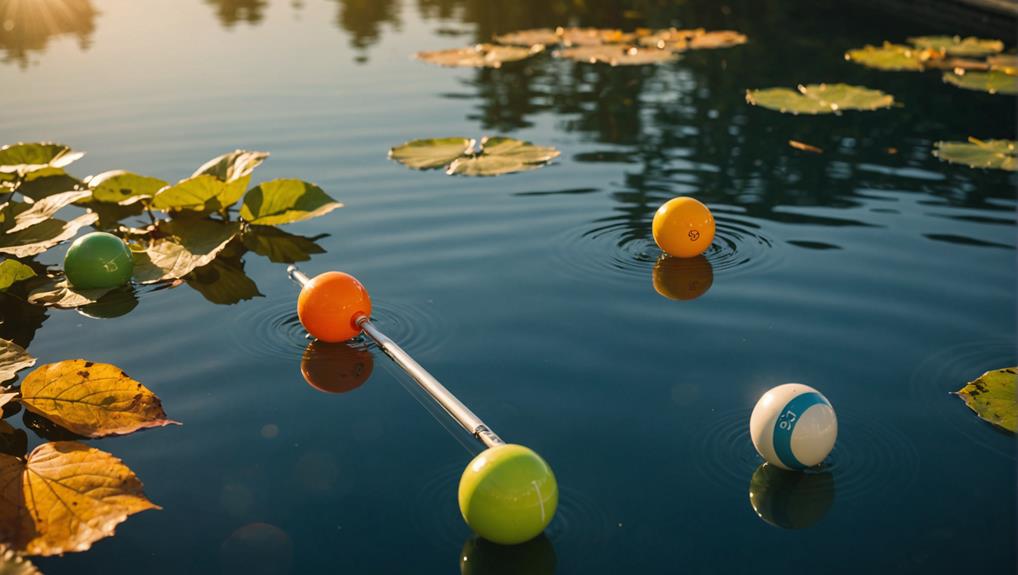You know maintaining balanced pool chemistry is vital, but where do you start? First, test your pool water regularly to catch any chemical imbalances early. Then, calculate your pool volume accurately to guarantee you're using the right amount of chemicals. Balance your alkalinity levels first, as they impact pH levels and overall pool chemistry. Adjust pH levels with care, aiming for 7.2-7.8. Monitor calcium hardness closely to prevent pool damage, and sanitize your pool water properly by regulating chlorine and cyanuric acid levels. Finally, consider your pool's temperature impact on sanitizer performance. Now that you've got the basics down, dive deeper into the details to confirm your pool is always safe and healthy.
Key Takeaways
- Regularly test pool water chemistry to identify imbalances and prevent issues like cloudy water, eye irritation, and equipment damage.
- Accurately calculate pool volume to ensure correct chemical dosing, calcium hardness, and alkalinity levels.
- Balance alkalinity levels first, as they significantly impact pH levels and overall pool water chemistry, aiming for 80-120 ppm.
- Monitor and adjust pH levels with precision, aiming for 7.2-7.8, to ensure sanitizer effectiveness, swimmer comfort, and equipment longevity.
- Consider calcium hardness, temperature, and cyanuric acid levels when adjusting pool chemistry to maintain a balanced and safe swimming environment.
Test Your Pool Water Regularly
When it comes to maintaining a safe and healthy swimming environment, testing your pool water regularly is essential, as it allows you to identify and address chemical imbalances and potential issues before they become major problems.
You'll want to test your pool water at least two to three times a week, or daily if kids use the pool regularly. This frequency helps guarantee a cloud-free, crystal-clear, and safe swimming pool.
You can use test strips for a quick assessment of pH, alkalinity, and chlorine levels. Alternatively, pool testing kits provide a more detailed analysis of pool water chemistry.
Digital pool testers offer convenience and detailed readings, and can even connect to your smartphone or device.
By testing your pool water regularly, you'll be able to identify chemical imbalances and make adjustments to maintain a balanced pool chemistry. This balance is vital, as it prevents issues like cloudy water, eye irritation, and damage to your pool equipment.
Calculate Your Pool Volume Accurately
To calculate your pool volume accurately, you'll need to gather some key measurements.
You'll need to measure the length of your pool, as well as the water depth at its deepest and shallowest points.
With these numbers in hand, you can plug them into the pool volume formula to get an exact calculation.
Pool Volume Formula
Calculating your pool's volume accurately is essential for maintaining balanced pool chemistry, and it all starts with measuring the length, width, and average depth of your pool.
To get it right, you'll need to use the correct formula based on your pool's shape. For rectangular pools, the formula is simple: Volume = Length x Width x Average Depth x 7.5.
For circular pools, use Volume = π x Radius² x Average Depth x 7.5, where Radius is the distance from the center to the edge.
Oval pools require a slightly different approach: Volume = (Length x Width) / 2 x Average Depth x 7.5.
And for kidney-shaped pools, you'll need to combine formulas for rectangular and circular pools to estimate the volume.
Accurate pool volume calculation is vital for balancing pool chemicals, maintaining ideal calcium hardness, and ensuring proper alkalinity levels. It also helps you determine the right amount of chlorinated shock chemicals to use and how to optimize your pool filters.
Measure Pool Length
You'll need to take precise measurements of your pool's length to get an accurate calculation of its volume. This is essential for balancing pool water chemistry, as it affects calcium hardness, total dissolved solids, and pH levels.
To maintain proper pool maintenance, you must measure the length correctly. For rectangular pools, measure the length from one end to the other, making sure to record the exact distance. For round, oval, or kidney-shaped pools, you'll need to measure the diameter or radius to calculate the length accurately.
When taking measurements, use a tape measure or ruler to get an exact reading. Make sure to record the measurement in feet, as this will be used in the pool volume formula. Remember, an accurate pool volume calculation is imperative for proper dosing of chemicals, guaranteeing the pool is safe and healthy for swimmers.
With the correct length measurement, you'll be able to calculate the pool volume accurately, which will help you maintain ideal water chemistry. By doing so, you'll be able to monitor and adjust pH levels, calcium hardness, and total dissolved solids using test strips and pool equipment, resulting in a well-balanced pool.
Record Water Depth
With your pool's length measurement in hand, now measure the water depth at the deepest point to determine the average water depth, which is essential for calculating the pool volume accurately.
Take note of the water level at the skimmer and the floor of the pool to get an accurate reading. You'll need this information to calculate the volume of your pool, which affects your pool water chemistry.
Accurate pool volume calculation is critical in achieving a balanced pool water chemistry. It guarantees you're adding the right amount of calcium hardness, chlorine, and other chemicals to maintain ideal levels.
For instance, if you're trying to raise your total alkalinity, you'll need to add baking soda in the correct dosage, which is dependent on your pool volume. On the other hand, if you need to lower your pH, you'll need to add muriatic acid in the right amount.
When you test the water, you'll be able to make informed decisions about your pool chemistry. By doing so, you'll be able to achieve a stable pool water balance, which is crucial for the health and safety of your swimmers.
Calcium chloride, for instance, can help stabilize your pool chemistry.
Balance Alkalinity Levels First

Now that you've calculated your pool volume accurately, it's time to focus on balancing your alkalinity levels.
You'll need to adjust these levels to maintain your pool water remains stable and safe for swimmers.
To do this, you'll need to understand the different alkalinity adjustment methods and the ideal level ranges for your pool.
Alkalinity Adjustment Methods
To balance your pool's alkalinity levels, you can use sodium bicarbonate (baking soda) to increase them or dry or muriatic acid to decrease them, following specific guidelines for each adjustment method.
When increasing alkalinity levels, a general rule of thumb is to add 1.5 pounds of baking soda per 10,000 gallons of water to raise alkalinity by 10 ppm. You can add baking soda directly to the pool water or premix it with water in a bucket before adding it to the pool.
When decreasing alkalinity levels, use caution as muriatic acid can also lower pH levels. Add it slowly while monitoring pH levels to avoid sudden changes. Make adjustments in small increments, such as 10-20 ppm at a time, and then retest the water to verify the desired level has been reached.
Remember, it's vital to test and adjust alkalinity levels before adjusting pH levels, as alkalinity affects pH stability. Improper alkalinity levels can make it difficult to achieve a stable pH, which is essential for balanced pool water chemistry and calcium hardness.
Alkalinity Level Ranges
You should aim to maintain total alkalinity levels between 80-120 parts per million (ppm) to guarantee a stable and balanced pool water chemistry. This range allows for a comfortable and safe swimming experience, while also protecting your pool surfaces and equipment from damage.
| Alkalinity Level | Effects on Pool Water Chemistry |
|---|---|
| Low (<80 ppm) | pH levels fluctuate, causing eye and skin irritation, corrosion of equipment, and etching of pool surfaces |
| Ideal (80-120 ppm) | Stable pH levels, comfortable swimming experience, and protection of pool surfaces and equipment |
| High (>120 ppm) | Cloudy water, reduced sanitizer effectiveness, and scaling on pool surfaces and equipment |
If your alkalinity levels are off, you can adjust them by adding sodium bicarbonate (baking soda) to increase levels or muriatic acid to decrease levels. Remember, balancing alkalinity levels first is essential, as they have a significant impact on pH levels and the overall stability of pool water chemistry. By maintaining the ideal range, you'll be able to balance your calcium hardness and pH levels more easily, ensuring a safe and enjoyable swimming experience.
Adjust Ph Levels With Care
Fluctuations in pH levels can have devastating effects on your pool's ecosystem, making it essential to adjust them with precision and caution.
When adjusting pH levels, you're not just tweaking a single parameter – you're balancing the entire pool water chemistry.
To achieve harmonious balance, follow these guidelines:
Test the water regularly: pH levels can fluctuate rapidly, so it's vital to test the water frequently to catch any deviations early.
Use the right chemicals: Soda ash (sodium carbonate) increases pH levels, while muriatic acid or sodium bisulfate decrease them. Be cautious when adding chemicals, as overcorrection can lead to further imbalance.
Consider total alkalinity: When adjusting pH, remember that alkalinity also affects the pool's ability to resist pH changes. Verify your total alkalinity is within the ideal range (80-120 ppm) to maintain a stable pH.
Shock the pool after major adjustments: After making significant pH adjustments, shock the pool to oxidize any built-up contaminants and prevent further imbalance.
Monitor Calcium Hardness Closely

Calcium hardness levels play a critical role in maintaining your pool's integrity, as they directly impact the longevity and appearance of its surfaces and equipment.
As you balance your pool water chemistry, monitor calcium hardness closely to prevent damage. If your calcium hardness levels drop below 150 ppm, you risk erosion, etching, and pitting of tile grout, plaster, pebble, and concrete surfaces.
To avoid these issues, aim for an ideal calcium hardness range of 200-400 ppm, with 150-800 ppm being an acceptable range. Soft water with low calcium hardness can lead to cloudy pool conditions and scaling on pool surfaces and plumbing.
To raise calcium hardness levels, you can use calcium chloride (Leslies Hardness Plus) in increments. However, if your calcium hardness exceeds 600 ppm, you may need to partially drain the pool and refill with fresh water.
But before doing so, consult a pool professional to prevent irreversible damage. By keeping a close eye on calcium hardness, you'll maintain your pool maintenance on track, and your pool remains safe and beautiful for years to come.
Sanitize Your Pool Water Properly
Proper sanitization of your pool water is essential, as it eliminates harmful microorganisms that can cause health issues and unpleasant odors.
As you balance your pool water chemistry, you'll need to verify chlorine levels are adequate to sanitize the water.
Maintain ideal chlorine levels: Aim for 1-3 parts per million (ppm) of free chlorine in the water.
Monitor pH levels: Regulate pH levels to be between 7.2 and 7.8 to maximize chlorine effectiveness.
Test and adjust cyanuric acid levels: Cyanuric acid helps stabilize chlorine, but excessive levels can reduce chlorine's sanitizing power. Aim for 30-50 ppm.
Shock the pool regularly: Use oxidizers like potassium monopersulfate to remove built-up contaminants and restore chlorine's effectiveness.
Remember to test and adjust your pool water chemistry regularly to confirm sanitization is effective.
Don't forget to check TDS levels and calcium hardness levels to prevent scaling and corrosion.
Are the Essential Tips for Balanced Pool Chemistry Also Necessary for Safe Pool Water Conditions?
Yes, the essential tips for balanced pool chemistry are crucial for maintaining safe pool water conditions. Following the safe pool water conditions steps ensures that the chemical levels are properly balanced, preventing the growth of bacteria and algae and ensuring that the water is safe for swimming.
Consider Your Pool's Temperature Impact

The answer lies in the fact that temperature profoundly affects the performance of your sanitizer. Warmer water requires more sanitizer to achieve the same level of disinfection as cooler water.
To be precise, for every 10°F (5.6°C) increase in water temperature, the chlorine demand increases by 10-15%. This means you'll need to adjust your chlorine levels accordingly. For temperatures below 78°F (25°C), 1-3 ppm of free chlorine is recommended, while temperatures above 85°F (29°C) require 3-5 ppm.
Temperature also influences the solubility of calcium hardness, making it more prone to scaling at higher temperatures.
To avoid this, it's vital to monitor your calcium hardness levels and adjust them based on your pool's temperature. A Saturation Index calculator can help you determine the ideal chemical levels for your pool water chemistry, taking into account factors like temperature, pH, and more.
Frequently Asked Questions
How Do I Keep My Pool Chemicals Balanced?
You maintain balanced pool chemicals by daily testing water clarity and pH levels, storing chemicals properly, using automatic feeders, and adjusting for seasonal changes, weather effects, pool age, and bather load according to your maintenance schedule.
How Do You Fix a Chemical Imbalance in a Pool?
You fix a chemical imbalance in a pool by identifying the issue, then applying targeted solutions like shock treatment, pH adjustment, alkalinity boost, or calcium buildup correction, while monitoring stabilizer levels, copper contamination, and chlorine overdose, and considering enzyme addition, filter cleaning, and bacteria growth prevention.
What Order Should I Fix My Pool Chemistry?
"Did you know 75% of pool owners struggle with chemical imbalances? To fix yours, you'll need a prioritization strategy: follow a step-by-step guide, using a chemical sequencing approach, to optimize your correction timeline, adjustment protocol, and parameter priority, ensuring a balancing roadmap for a perfectly harmonious pool."
What Is the Ideal Chemical Balance for a Swimming Pool?
You'll achieve ideal pool chemistry by maintaining pH levels between 7.3-7.8, passing alkalinity tests, and balancing calcium hardness, stabilizer, and sanitizer levels, including chlorine and bromine, to guarantee crystal-clear water with proper mineral content and effective oxidation methods.
Conclusion
As you enter the world of balanced pool chemistry, remember that it's a delicate dance.
With these 7 essential tips, you'll be well on your way to creating a harmonious blend of chemicals that'll keep your pool sparkling like a diamond.
By following these steps, you'll avoid the chaos of cloudy water and algae growth, and instead, enjoy a safe and healthy swimming environment.
Stay vigilant, and your pool will be the epitome of relaxation and fun all season long.

I’m Max, the founder and chief pool enthusiast behind Pool Pro Tips. As a passionate pool owner and cleaning expert, I created this website to share my knowledge and experience with you, helping you to keep your pool sparkling clean and safe for years to come.

